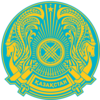دونگان (شعب)
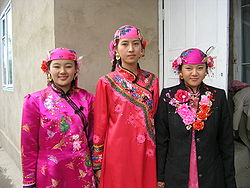 بنات دونگان في شور-تيوبه، قزخستان. | |
| التعداد الإجمالي | |
|---|---|
| 110,000 | |
| المناطق ذات التواجد المعتبر | |
| 36,900 | |
| 801 | |
| 51,766 | |
| اللغات | |
| دونگان | |
| الديانة | |
| الاسلام | |
| الجماعات العرقية ذات الصلة | |
| هوي | |
الدونگان (روسية: Дунгане) هو تعبير يستخدم في أراضي الإتحاد السوفيتي السابق للإشارة إلى شعب مسلم من أصل صيني. الشعوب الناطقة بالتوركية في مقاطعة شينجيانگ في الصين يشيرون أيضاً إلى أعضاء هذه الجماعة العرقية باسم دونگان. إلا أنه في كل من الصين والجمهوريات السوفيتية السابقة حيث يعيشون، فإن أعضاء تلك الجماعة العرقية يسمون أنفسهم هوي.
تاريخ
الهجرة من الصين
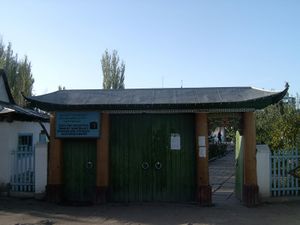
الاسم
| دونگان | |||||||
|---|---|---|---|---|---|---|---|
| Chinese name | |||||||
| الصينية التقليدية | 東干族 | ||||||
| الحروف المبسطة | 东干族 | ||||||
| |||||||
| Dunganese name | |||||||
| Dungan | Хуэйзў | ||||||
| Xiao'erjing | حُوِ ذَو | ||||||
| Romanization | Huejzw | ||||||
| Hanzi | 回族 | ||||||
| Russian name | |||||||
| Russian | Дунгане | ||||||
في الامبراطورية الروسية، والاتحاد السوڤيتي والدول ما بعد السوڤيتية، الدونگان مازالوا يشيرون إلى أنفسهم بإسم شعب هوي (الصينية: 回族, Huízú؛ في التهجي بالسيريلية الدونگانية السوڤيتية، xуэйзў).
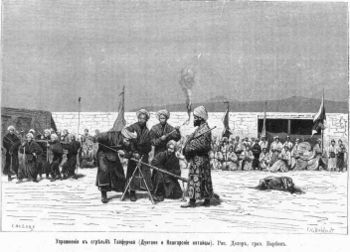
الكلمة (mostly in the form "Dungani" or "Tungani", sometimes "Dungens" or "Dungans") acquired some currency in English and other western languages when a number of books in the 1860-70s discussed the تمرد الدونگان في شمال غرب الصين. At the time, one could see European and American authors apply the term Tungani to the Hui people both in Xinjiang,[1]
and in Shaanxi and Gansu (which at the time included today's Ningxia and Qinghai as well). Authors aware of the general picture of the spread of Islam in China, viewed these "Tungani" as just one of the groups of China's "Mohammedans".[2]
قرى الدونجان في قزخستان وقيرغيزستان
الدونجان أنفسهم يشيرون إلى Karakunuz (روسية: Каракунуз, sometimes Караконыз or Караконуз) as Ingpan (الصينية: 营盘, Yingpan; روسية: Иньпан), which means 'a camp, an encampment'. In 1965, Karakunuz was renamed Masanchi (sometimes spelt as "Masanchin"), after Magazi Masanchi or Masanchin (Dungan: Магәзы Масанчын; الصينية: 马三青)، مشارك دونگاني في الثورة الشيوعية ورجل دولة في قزخستان السوڤيتية.
| اسم القرية (وبدائله) | الموقع (بالمصطلحات الحالية) | التأسيس | التعداد الحالي للدونگان (من ما تانگ (2003)) |
|---|---|---|---|
| قزخستان - إجمالي 48,000 (Ma Tang (2003)) أو 36,900 (تعداد قزخستان 1999) | |||
| Masanchi (روسية: Масанчи; قزخ: Масаншы) or Masanchin (بالروسية: Масанчин; سيريلية الدونگان: Масанчын; 马三青), prior to 1965 Karakunuz (Каракунуз, Караконыз). الاسم الدونگاني التقليدي هو Ingpan (سيريلية الدونگان: Йинпан؛ بالروسية: Иньпан; الصينية: 营盘, Yingpang) | (42°55′40″N 75°18′00″E / 42.92778°N 75.30000°E) Korday District, Zhambyl Province of قزخستان (8 km north of Tokmok, قيرغيزستان) | Spring 1878. 3314 شخص من Shaanxi, led by Bai Yanhu (白彦虎). | 7,000, current mayor: Ishar Ussupovich Lou |
| Sortobe (قزخ: Sortobe; روسية: Шортюбе, Shortyube; دونگان: Щёртюбе; الصينية: 雪尔秋白, Xuerqiubai) | (42°52′00″N 75°15′15″E / 42.86667°N 75.25417°E) Korday District, Zhambyl Province. On the northern bank of the Chui River opposite and a few km downstream from Tokmok; south of Masanchi (Karakunuz) | (Karakunuz group) | 9,000 |
| Zhalpak-tobe, (قزخ: Жалпак-тобе; الصينية: 加尔帕克秋白, Jiarpakeqiubai) | Zhambyl District, Zhambyl Province; near Grodekovo، جنوب Taraz | 3,000 | |
| قيرغيزستان - إجمالي 50,000 (Ma Tang (2003) | |||
| Yrdyk روسية: Ырдык or Ирдык; دونگان: Эрдэх; الصينية: 二道沟, Erdaogou) | (42°27′30″N 78°18′0″E / 42.45833°N 78.30000°E) Jeti Oguz district of Issyk Kul Province; 15 km south-west from Karakol. | Spring 1878. 1130 people, originally from Didaozhou (狄道州) in Gansu, led by Ma Yusu (马郁素), a.k.a. Ah Yelaoren (阿爷老人). | 2,800 |
| Sokuluk (روسية: Сокулук; Dungan: Сохўлў; الصينية: 梢葫芦, Saohulu); may also include adjacent Aleksandrovka (Александровка) | Sokuluk District of Chuy Province; 30 كم غرب بيشكك | Some of those 4,628 Hui people who arrived in 1881-1883 من حوض إيلي (Xinjiang) . | 12,000 |
| Milianfan (روسية: Милянфан; دونگان: Милёнчуан; الصينية: 米粮川, Miliangchuan) | Ysyk-Ata District of Chuy Province. Southern bank of the Chuy River, some 60 km west of Tokmok and about as much north-east من بيشكك. | (Karakunuz group (?)) | 10,000 |
| Ivanovka village (روسية: Ивановка; الصينية: 伊万诺夫卡) | Ysyk-Ata District of Chuy Province. الضفة الجنوبية لـ نهر تشوي، على بعد نحو 30 كم غرب من توكموك. | (Karakunuz group (?)) | 1,500 |
| Dungan community of اوش (روسية: Ош, الصينية: 奥什 أو 敖什, أوشه) | مدينة اوش | ربيع 1878، 1000 شخص، أصلاً من تورپان في شينجيانگ، بقيادة ما دارن، ويـُعرف أيضاً باسم ما دا-لاو-يه (马大老爷) | 800 |
الزمن الحالي
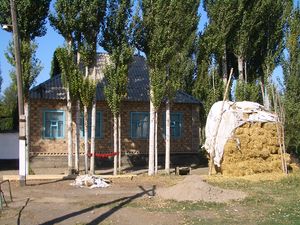
الدين
الغالبية العظمة من الدونجان يتبعون المذهب الحنفي ، مع أقلية من المذهب الحنبلي. ويحتوي العديد من قرى الدونجان على مسجد يديره كبار السن في القرية.
Some ascribe the rise of Islam amongst the Dungans to an alleged Arab ancestry. While this may be possible for some Dungans (though not likely), it is more plausible that the prevalence of Islam amongst them is due in part to the freedom Arab preachers were given by الامبراطور گاوزونگ من أسرة تانگ in the 7th Century CE. أيضاً، هناك سبب أكثر احتمالاً وهو اعتناقهم للإسلام على أيدي المنغول, بركة خان والقبيل الذهبي بالتحديد، وكذلك على يد الأمم المجاورة.
الهامش
- ^ فعلى سبيل المثال، يكتب توماس إدوارد گوردون عن the "Tunganis" with taifu wall pieces (small cannons) تحرس أسوار عاصمة يعقوب بك قشغر (في غرب Xinjiang الحالية) في كتابه The roof of the world: being a narrative of a journey over the high plateau of Tibet to the Russian frontier and the Oxus sources on Pamir. A Times journalist in "Russia and China in Central Asia" (reprinted by The Brisbane Courier, Wednesday 8 January 1879) distinguishes "the Tungan Country" (today, eastern Xinjiang) and "Eastern Turkestan" (corresponding to Yaqub Beg's state in today's western Xinjiang). He talks about "the Tungani who had erected in the various cities of Hamil, Barkul, Guchen, Urumtsi, and Manas a confederacy of no mean power".
- ^ See e.g. an anonymous article, "Mohammedanism in China", in The Living age, Volume 145, Issue 1876. May 29, 1880. Pp. 515-525. Reprinted from the Edinburgh Review. While using "Mohammedans" as the generic description of Chinese Muslim's throughout the article (including e.g., the Panthays then recently rebelling in Yunnan), the author describes "[a]n insurrection, beginning in Singan-fu, and spreading to Kan-suh in 1862, in which the Tungani (a mysterious race of Mohammedans dwelling in that region, supposed to be the remnant of the armies of قبلاي خان) were the chief actors" (p. 524).
وصلات خارجية
- Articles using infobox ethnic group with image parameters
- Articles containing روسية-language text
- Pages using Lang-xx templates
- Articles containing صينية-language text
- Articles containing Chinese-language text
- Articles containing قزخ-language text
- Pages using gadget WikiMiniAtlas
- Articles containing Dungan-language text
- شعب الهوي
- جماعات عرقية في قزخستان
- جماعات عرقية في قيرغيزستان
- جماعات عرقية في روسيا
- جماعات عرقية في أوزبكستان
- جماعات عرقية في آسيا
- جاليات مسلمة
- روس من أصل صيني
